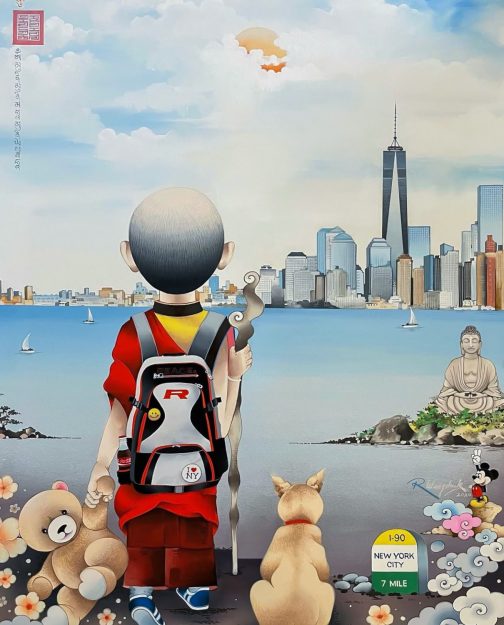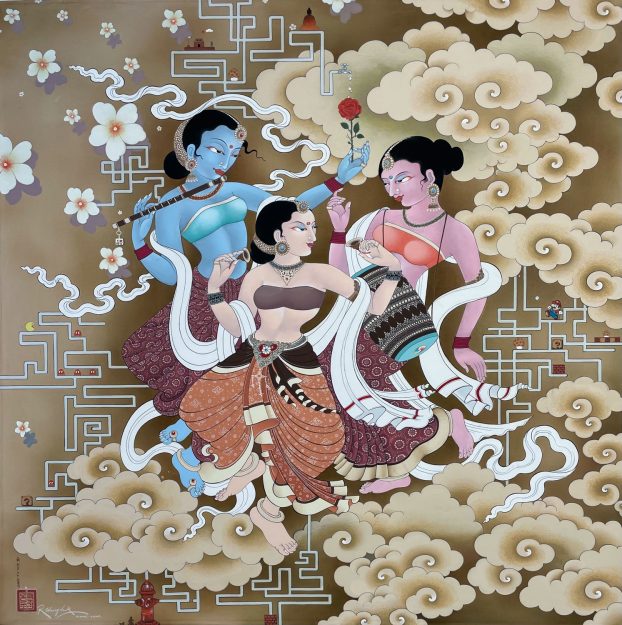During the lockdown days of the pandemic, when so many people felt aimless at home, Tibetan artist Rabkar Wangchuk was painting every day. The result is a new show called Mystery of Life at New York City’s Here Now gallery, curated by Paola Vanzo and on view through June 21. The show is dedicated to Wangchuk’s mother, who died during the pandemic, and includes sculptures from guest artist Michela Martello.
Wangchuk, who was born in India and lived in a monastery from age seven to twenty, has always been an artist. After learning the traditional Tibetan art forms of thangka painting, wood carving, butter sculpture, and sand mandalas at the monastery, he started exploring contemporary art when he left to study at the Tibetan Institute of Performing Arts. His teacher encouraged him to explore other styles and he found inspiration in the painting of Salvador Dalí, Pablo Picasso, and other artists whose work he felt represented a “freedom of spirit.”
“I can be hungry for two or three days, but I can’t stand one day without art,” Wangchuk told me when I visited the show. “Art nourishes my spirit.”

Eventually Wangchuk came to the United States to teach, first at the University of Texas, San Antonio, and then in New York City, where he currently lives. Though his art has appeared in numerous group shows, Mystery of Life is the artist’s first solo exhibit. Departing from much of his previous work, Wangchuk used mineral pigments as opposed to acrylics in this collection of paintings, which allows him to be more precise. As a result, the paintings are brimming with detail. But they also have an unmistakably serene quality to them. The contradiction is one Wangchuk attributes to his daily meditation practice—his morning prayers and mantras that he calls “breakfast for the spirit.” The practice keeps him calm and imbues his art with positivity, he says, even as the intricate details sweep viewers up in the complexity and struggle of daily life.

The co-existing sense of calm and activity also reflect the artist’s internal state during the pandemic and after the death of his mother. “Before my mother died I was carefree, but then I became lonely… She left me in this busy world,” he says.
Wangchuk was able to visit his mother in India before she died, but when he returned, he painted the story of his life in a dedication to her. Many of the paintings include female figures who represent his mother or the concept of motherly love, and almost every painting includes the image of a small monk, who represents the artist moving throughout his life. Most paintings also include images of familiar cartoon characters like Mickey Mouse and Dumbo—playful pop culture anchors that the artist, a self-proclaimed movie lover, uses to express himself and connect with diverse audiences. Various styles, including the more traditional Chinese painting style of the Ming dynasty, are intended to appeal to a wide audience, too.
Throughout my visit to the Here Now gallery, Wangchuk repeated that he wanted his art to connect with viewers—a concern surely amplified by the disconnected time of lockdown. Driving that home, curator Paola Vanzo invited Italian multidisciplinary artist Michela Martello to contribute eight vases inspired by Tibetan culture and a series of hands and feet to add a feminine influence to the show in honor of Wangchuk’s mother. The result is a diverse collection of styles that feel fresh and positive, but also packed with personal history and emotion, often with undercurrents of struggle and longing.
Mystery of Life is on view at the Here Now gallery until June 21. See below for details on events, including an artist’s talk and a meditation session with David Nichtern.



♦
Tuesday, June 7
Opening reception at 6:30 p.m. EDT
Here Now Space
132 Perry Street 2B, New York NY 10014
Saturday, June 11
Artist’s Talk with Rabkar Wangchuk and Michela Martello
The talk will be moderated by Daniel Aitken (CEO/Publisher, Wisdom Publications) 6:30–8:30 p.m. EDT at Here Now Space
RSVP at info@herenowspace.com
Wednesday, June 15
Meditation session with David Nichtern, Emmy Award-winning composer and author of Awakening From the DayDream and Creativity, Spirituality, and Making A Buck, published by Wisdom.
6:30–8:30 p.m. EDT at Here Now Space
Register here
Tuesday, June 21
Closing reception at 6:30–8:30 p.m. EDT
Thank you for subscribing to Tricycle! As a nonprofit, we depend on readers like you to keep Buddhist teachings and practices widely available.
